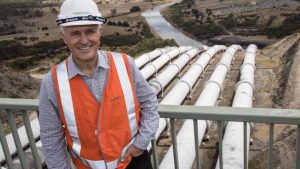Evolutionary biologists used to believe that species change very gradually over time. A deer’s neck gets long and longer over millions of years and – voilà – you have a giraffe.
However, in 1972, Stephen Jay Gould and Niles Eldrege published a paper on ‘punctuated equilibrium’, which argued that many species stay pretty similar for millions of years (equilibrium), and suddenly change dramatically over a few generations in response to disruptions, such as changes to their environment.
This concept of ‘punctuated equilibrium’ is pretty useful for thinking both about our energy system and cultural change. Both in Australia and globally, the electricity system was pretty stable for 60 years.
While new technologies appeared over this period, there wasn’t enough pressure to shift the way that our energy system ran.
And then, all at once, everything changed.
There has been pressure to reduce our greenhouse emissions since at least 1992, but the dramatic fall in the cost of solar and wind generation in the last decade have made the shift inevitable.
In 2015, there was a fundamental change in the debate, as large energy businesses made it clear that the future of energy was built on renewables.
The transition to renewables has been sped up by the rapid rise in gas prices and a number of large coal-fired generators hitting their retirement age.
Australia’s old coal-fired generators are feats of engineering that have operated for years at incredible temperatures, and as they age it becomes exponentially more difficult and expensive to extend their life.
This is not theory – this is fact. The former Western Australian government learnt this the hard way, investing $300 million to upgrade the Muja AB coal-fired units, and then closed them following an explosion in 2012.
The rapid roll-out of solar panels means that Australia is now at the very forefront of the global transition to renewable energy, and this has fundamentally changed our energy debate.
For decades, experts have been saying that the way that we use energy is just as important as the way that we generate it.
For decades, Australia largely ignored the opportunities presented by smarter energy use.
However, the change in our energy system means that consumers, businesses and governments are now VERY interested in energy management.
Smarter energy use is finally moving to the centre of the energy debate, because we need it to ensure that energy remains affordable and reliable as we transition to clean energy.
The shift in the debate was incredibly clear at the Energy Efficiency Expo and All Energy Exhibition and Conference, which took place in Melbourne on 23rd and 24th October. In previous years, the debate was firmly focused on renewable energy.
This year, expert after expert lined up to say that we need to focus on integrating all our energy resources, including solar, wind, storage and energy management.
The world’s first fuel
‘Energy management’ is a broad term that encompasses changing how much energy we need (e.g. an LED lightbulb produces better light than an incandescent bulb for 90 per cent less energy) and when we use it (e.g. running water pumps when energy supply is plentiful).
Earlier this year, the Energy Efficiency Council launched a landmark report, The World’s First Fuel’, which drew on international research that showed that energy management had provided more ‘capacity’ to energy markets than any form of generation.
For example, minimum energy efficiency standards for fridges and freezers mean that Australia saves over 300 Megawatts of electricity, 24 hours a day, 365 days a year.
In other words, minimum standards for refrigeration provide more capacity than most coal-fired generating units.
While places like the US, China, Germany and Japan have actively used energy management for decades to ensure that energy remains reliable and affordable, Australia has largely ignored this opportunity.
In 2018, a global report rated Australia as the worst developed country out of the world’s top 25 energy users for energy efficiency policy and practice.
The good news is that this means that Australia has a huge untapped opportunity to boost reliability, cut energy bills and dramatically cut emissions.
It seems that this message is finally cutting through. While Australian governments are struggling to agree to a sensible plan for energy supply, there’s an emerging consensus that energy management is something we can, and should, act on immediately.
In June, Angus Taylor, the federal Minister for Energy and Emissions told delegates at the Energy Week Conference
“We see enormous potential in energy efficiency across the economy… our commitment to improving energy efficiency across Australia is helping to reduce emissions while bringing down energy bills for households and businesses.”
From the other side of the political aisle, Lily D’Ambrosio, the Victorian Minister for Energy, Environment and Climate Change, stated earlier this year that:
“Improving energy efficiency creates jobs, reduces emissions and helps Victorians homes and business save money on their power bills.”
This growing consensus is translating in real progress, but there’s a long way to go.
Australian policies
The energy efficiency of Australia’s existing homes is exceptionally poor by global standard.
This doesn’t just mean higher energy bills – it also contributes to an estimated 2,600 deaths each year from cold weather, almost double the rate of cold-associated deaths as Stockholm in Sweden.
Hundreds of Australians also die each year during heatwaves, a problem that is only going to get worse with rising global temperatures. The quality of our housing stock is a national shame.
However, Australia’s building industry, welfare organisations and consumer groups have become world leaders in collaboration. A broad range of organisations have been advocating hard for policies to improve new and existing buildings.
Most recently, on 29 October, the Property Council and Green Building Council launched a plan to dramatically cut emissions in the built environment, Every Building Counts.
By working together, these organisation are starting to drive real reforms. In February 2019 the COAG Energy Council agreed to a Trajectory for Low Energy Buildings, which sets out a plan to dramatically improve the energy efficiency of both new and existing buildings.
The 2019 edition of the National Construction Code dramatically raised the minimum standards for commercial buildings, and work is underway to raise standards for residential buildings in 2022.
The Queensland, Victorian and ACT Governments have all committed to introduce minimum energy efficiency standards for rental homes, which should come into force in the next couple of years.
However, there is far more to do. In 2010, there was bipartisan support for the Commercial Building Disclosure program, which required offices to disclose their energy efficiency during sale or lease.
As a result, the energy use per square meter in Australia’s larger offices has fallen a remarkable 30 per cent over the last nine years.
The Australian Government is currently considering extending disclosure to hotels, but we also need disclosure for homes, shopping centres and other key classes of building.
To date, there has been far less support for energy efficiency in industry than in buildings. Australian industry now has the lowest energy productivity in the OECD, which means that we’re making less money out of each unit of energy that we use. Given the high price of electricity and gas in Australia, this is a huge problem.
The NSW government has stepped up with a well-designed program to help manufacturers save energy, but other governments need to significantly raise the support that they are offering to this sector.
One significant opportunity for both manufacturing and buildings is the review of the Australian Government’s Emissions Reduction Fund (ERF).
As the EEC has argued for many years, the ERF is not well suited to supporting energy efficiency upgrades, and the Australian Government is now considering alternative mechanisms to drive this low-cost abatement opportunity.
The EEC recently joined a range of leading organisation in a joint submission to this review, and we anticipate announcements in coming months.
In energy markets, well-established programs have continued to deliver results for consumers. NSW, Victoria, South Australia and the ACT all require energy retailers to help consumers to save energy (sometimes called ‘energy efficiency schemes’).
The ACT government has announced that it will extend its scheme to 2030 and NSW, Victoria and South Australia will all consider the extension of their schemes in coming months.
The Queensland government has been considering introducing a scheme for several years now, although it still hasn’t made an announcement on when, or if, it will catch up with other states.
However, probably the largest shift in the last year has been around the fundamental design of our energy markets.
In July the Australian Energy Market Commission (AEMC) released its proposed design for a mechanism to reward consumers if they reduce their energy demand during high-price periods, the ‘Demand Response Mechanism’.
On 25 November the Energy Efficiency Council’s will hold a forum on how demand response will support the shift to renewable energy, which will be followed by the AEMC releasing its final decision on the Demand Response Mechanism.
In summary, it has been a remarkable year in the energy sector. It is fair to say that decades of relative equilibrium have been well and truly punctuated. Energy management is finally coming to the centre of the debate.







